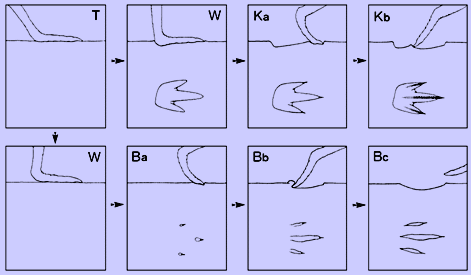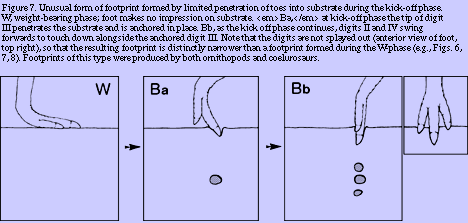
|
REPRINT FROM
DINOSAUR TRACKS AND TRACES
Edited by DAVID D. GILLETTE AND MARTIN G. LOCKLEY
Cambridge University Press, 1989
|
A FOOTPRINT AS A HISTORY OF MOVEMENT |
| RICHARD A. THULBORN AND MARY WADE |

|
|
Figure 1. Morphological features of coelurosaur footprints (Skartopus australis) at Lark Quarry site, related to events during the trackmaker's step-cycle (see also Fig. 6). Each diagram shows position of foot in profile (above) and corresponding plan view of the right footprint (below). T, touch-down phase; the foot makes little or no impression on the substrate. W (upper row), weight-bearing phase; the foot sinks into the substrate. Ka, kick-off phase; as foot is lifted from substrate the tips of the toes produce sharp imprints of the claws. Kb, kick-off phase (frequently following Ka); tips of the toes slip backwards, incising grooves in floor of footprint. W (lower row), weight-bearing phase; the relatively large and broad-spreading foot fails to sink into the substrate. Ba, kick-off phase; only the tips of toes break through the surface of the substrate. Bb, Bc (frequently following Ba), kick-off phase; tips of the toes break through the surface of the substrate and slip backwards to form sub-parallel furrows. |
|
Abstract
Introduction
We illustrate the morphological effects of these phases in a variety of footprints made by Cretaceous dinosaurs, both theropods and ornithopods. These footprints were found at a site known as Lark Quarry, in western Queensland, Australia (see Thulborn and Wade 1979, 1984; and Agnew et al. 1989)
The sediments at Lark Quarry are interbedded sandstones and claystones. These accumulated in the floor of a broad creekbed that drained into a lake or waterhole to the southwest. Each sandstone/claystone couplet presumably originated from a single major influx of sediment charged water. Dinosaur footprints occur at several horizons in the succession. At the single horizon discussed here nearly 4,000 footprints were excavated in the form of natural molds (concave epireliefs). All these footprints were impressed in a single bedding plane which defines the top of a laminated claystone bed with a total thickness ranging between 6 cm and 12 cm. The claystone is overlain and underlain by finely cross-bedded arkosic sandstones. Footprints
First Generation
These scattered prints were probably made by ornithopods that were swimming and only occasionally touching down on the bottom-much like the hadrosaur footprints described by Currie (1983) in the Cretaceous of Canada. The prints trapped some residual quartz sand, without appreciable feldspar, that had been winnowed across the subaqueously hardening mud, along with a few streaks of muddy sediment that was probably stirred up by dinosaurs venturing across the area before it drained free of water. The footprints represent fairly large animals; smaller dinosaurs might also have crossed the submerged area at about the same time, but these would not have left any traces if their legs were too short to have touched down.
At least one moderately large ornithopod traversed the area as it was draining free of water. This animal, estimated to have been about 1.6 m high at the hip, trotted across the southern part of the site from west-southwest to east-northeast (Fig. 2B). Some of its footprints were deeply impressed in saturated mud, which bulged up between the toes and behind the foot. This upwelling is most pronounced behind the footprint, indicating some backwards displacement of sediment at the end of the W-phase and during the K-phase. It is worth emphasizing that this displacement occurred in an almost horizontal substrate: evidently an upwelling of sediment behind a footprint does not necessarily indicate that the trackmaker was ascending a slope. Other footprints in the same trackway are not so deeply impressed nor so well preserved; they seem to have been formed in slightly lower-lying areas that were subject to scouring as the substrate finally drained free of water and became exposed to the air. Third Generation
The footprints resemble those in the ichnogenus Tyrannosauropus and were probably made by a carnosaur about 2.6 m high at the hip (Thulborn and Wade 1984). The first part of the carnosaur's trackway is noticeably different from the second (Fig. 3). Initially (strides 1-4) the footprints are relatively large and the animal took long strides; thereafter (strides 5-9) the footprints are smaller and stride length is reduced. This weaving trackway ends with an abrupt turn to the right, which presumably reflects a change in the trackmaker's behavior. We suspect that the carnosaur might have been approaching or stalking a group of dinosaurs gathered around the waterhole to the southwest (Thulborn and Wade 1984).
Fourth Generation
|

|
|
Ornithopod Footprints
During the W-phase the foot sometimes slipped backwards as it sank deeper, so that the front margins of the digital impressions are distinctly stepped or terraced (Fig. 5W). In addition the foot sometimes rotated outwards, so that digit III pointed directly ahead; similar traces of rotation or sideways slippage of the foot were described by Soergel (1925) in Chirotherium footprints. Since the foot was planted into the substrate (T-phase) with inwards rotation, but was withdrawn (K-phase) in a different direction (forwards or antero-laterally), the tip of digit III may appear to be forked or Y-shaped (e.g., Fig. 5W). During the K-phase the tips of the toes were the last parts of the foot to be withdrawn from the substrate. Sometimes the toes slipped backwards as they were being withdrawn, thus incising slots in the floor of the footprint (Fig. 5Kb). Occasionally the tips of the toes slipped back so far that they breached the rear wall of the footprint to leave retro-scratches (Fig. 5Kc). In some instances the tips of the toes did not slip backwards during the K-phase; instead they sometimes dragged through the front rim of the newly-formed footprint, to leave forwardly-directed scrape marks (Fig. 5Ka). Digit III was the longest in the trackmaker's foot and, for that reason, formed a scrape mark most frequently; digit II was the shortest in the foot and rarely produced a scrape mark. In a few cases the foot made no impression during the T-phase and W-phase, but broke through the surface during the K-phase, when a considerable fraction of the animal's body mass was supported only by the distal parts of the toes. The tip of the long middle toe (III) sank into the substrate, anchoring itself in place (Fig. 7Ba), then, as the K-phase continued, the flanking toes (III and IV) swung forwards to touch down alongside the anchored digit III (Fig. 7Bb). The result was an extremely distinctive one-phase footprint consisting of three puncture-like markings arranged side-by-side. Such footprints are noticeably narrower than those "normal" footprints where the trackmaker's toes splayed out sideways during the W-phase (cf. figs. 5, 6, 8). |

|
|
The axial digit (III) was probably the thickest in the trackmaker's foot and normally produced a correspondingly broad impression in the footprint (Fig. 8A,E-G). Sometimes the impact of this principal weight-bearing digit generated a thixotropic reaction in the underlying sediment; then, when the trackmaker's foot was withdrawn from the substrate, the fluid sediment flowed (or was sucked) inwards to leave a secondarily narrowed imprint of digit III (Fig. 8B-D).
At the start of this cycle (T-phase) the forwardly-extended foot was planted on the substrate, producing a very shallow footprint or no perceptible footprint at all (Fig. 1T). At mid-step (W-phase) the trackmaker's center of gravity passed forwards above the planted foot, which in some cases sank deeper into the substrate (Fig. 1W, upper row). During the K-phase the tips of the toes pressed down and slightly backwards to leave imprints of the sharply pointed claws (fig. 1Ka). Sometimes the tips of the toes slipped backwards during the K-phase, incising grooves in the floor of the footprint (Fig. 1Kb). Occasionally the tips of the toes continued to slip backwards, forming retro-scratches that breach the rear wall of the footprint (cf. Fig. 1Kb). Retro-scratches are commoner than in the ornithopod footprints, possibly because the coelurosaurs had less flexible toes. There is no obvious indication that the coelurosaur foot rotated in its footprint during the W-phase (as it did in the ornithopods, cf. Fig. 5W) nor of forwardly directed scrape marks from the tips of the digits (cf. Fig. 5Ka). In many cases the foot did not sink into the substrate during the T-phase or the W-phase (Fig. 1W, lower row). This seems to have happened very frequently, judging from the large number of "gaps" or "missing" footprints in the coelurosaur trackways at Lark Quarry. We suspect that the coelurosaurs had relatively large and broad-spreading feet that acted as analogues of snowshoes. Nevertheless the sharp tips of their claws did commonly break through the surface of the substrate during the K-phase, when the animal's body mass would have been supported by a small (and diminishing) area of the foot's undersurface (Fig. 1Ba). Then, quite frequently, the sunken tips of the toes lost their purchase in the muddy substrate and slithered backwards to leave a footprint consisting of superficial furrows or retro-scratches (Fig. 1Bb, Bc). Sometimes only one or two of the three digits broke through and furrowed the surface in this fashion. The coelurosaurs commonly produced distinctive one-phase footprints consisting of three puncture-like markings arranged side-by-side (Fig. 7). Finally, a few of the coelurosaur footprints include a trace of the metapodium (Thulborn and Wade 1984, plates 12, 13B, 14B). This is a large subrectangular impression behind the three digit impressions; it is no wider than the maximum spread of the digits and is roughly as long as the imprint of digit III. Such footprints are rare and seem to occur randomly within otherwise normal Skartopus trackways; however, one section of trackway shows a sequence of four such footprints. Presumably these footprints originated when the normally digitigrade trackmakers used a "flat-footed" gait. Kuban (1986) described somewhat similar footprints from the Cretaceous of the Paluxy River, Texas, but these appear to differ in one respect from those at Lark Quarry: the metapodium imprint is deeper than the digit imprints in the Paluxy River examples whereas it is shallower than the digit impressions in the Lark Quarry footprints. The significance of this distinction remains unknown. _________________ References
Agnew, N., Griffin, H., Wade, M., Tebble, T., and Oxnam, W. 1989. In D.D. Gillette and M.G. Lockley (ed) Dinosaur Tracks and Traces. (Cambridge University Press, 1989) pp. 360-366.
|
Return to:
Catherine Quéloz
interviews
Allan McCollum
Return to:
REPRINTS